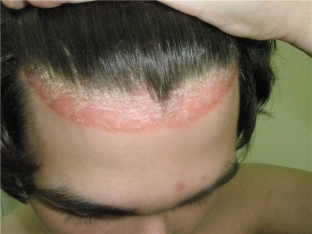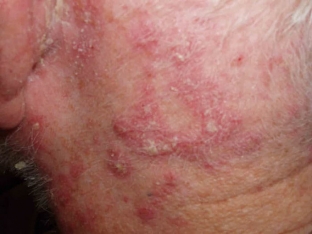Today, psoriasis is one of the most common and severe diseases in dermatology. Its various forms can affect patients of almost any gender and age, becoming a serious and very difficult to treat medical problem. Psoriasis – it is always a chronic pathology that can disturb the patient throughout his life. Seborrheic psoriasis is one of the most common forms of psoriasis, which is similar in pathogenesis to seborrheic eczema. Estet-portal.com talks today about the causes, main signs and methods of effective treatment of seborrheic psoriasis.
Seborrheic psoriasis – severe lichen squamous
Seborrheic psoriasis – it is a severe chronic disease that mostly affects the scalp, but can also be localized in other areas of the body, such as the chest, nasolabial folds, the area between the shoulder blades and behind the ears.
The foci of seborrheic psoriasis are separate areas of the skin that actively flake and itch, causing considerable discomfort to the patient and often causing psychological and social problems for the patient.
This is a severe chronic disease that is difficult to treat, and the best doctors can do – reduce the manifestations of pathology, thereby slightly improving the quality of life of the patient.
Seborrheic psoriasis:
- main causes of seborrheic psoriasis;
- characteristic clinical signs of seborrheic psoriasis;
- effective treatments for seborrheic psoriasis.
The main causes of seborrheic psoriasis
Seborrheic psoriasis, like some other dermatological pathologies, is a polyetiological disease, that is, the pathogenic influence of several factors can lead to its development:
- genetic factor: the disease was previously diagnosed in the patient's blood relatives;
- impaired functioning of the immune system;
- metabolic disorders in the body;
- exposure to the fungus "Malassesia", which develops in the secretion of the sebaceous glands;
- influence of the stress factor;
- Untimely or incorrect treatment of infectious diseases;
- AIDS.
Characteristic clinical signs of seborrheic psoriasis
The clinical picture of seborrheic psoriasis is quite specific and depends, first of all, on where exactly the area of the affected skin is located:
- local areas of psoriasis on the head pass from the forehead to the scalp, forming the so-called "psoriatic crown";

- seborrheic psoriasis around the auricles resembles eczema: dry crusts appear that crack, causing considerable discomfort to the patient;

- psoriasis on the face is accompanied by severe itching and flaking.
In seborrheic psoriasis, the affected skin is covered with gray scales, which are dead cells of the epidermis that have not had time to separate from the skin.
Effective treatments for seborrheic psoriasis
Treatment of seborrheic psoriasis should start as early as possible and have a comprehensive approach:
- as a local therapy, it is necessary to use cosmetic care products containing corticosteroids, cytostatics, antifungal and anti-inflammatory components;
- monoclonal antibodies are used to stimulate the immune system;
- vitamin therapy also has an immunostimulating and restorative effect;
- sedatives are recommended for those patients whose illness is associated with the influence of a mental factor;
- hormonal ointments for external use help to eliminate the inflammatory process;
- laser therapy and ultraviolet radiation can also be very effective for seborrheic psoriasis.
Complex therapy of seborrheic psoriasis, correctly selected by a specialist, helps to significantly reduce the manifestations of the disease and alleviate the patient's condition.
But unfortunately, it is currently impossible to completely cure this severe chronic disease, like other types of psoriasis.







Add a comment